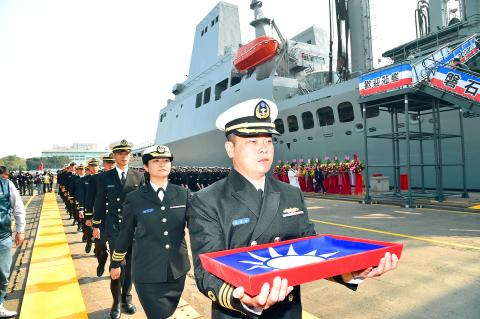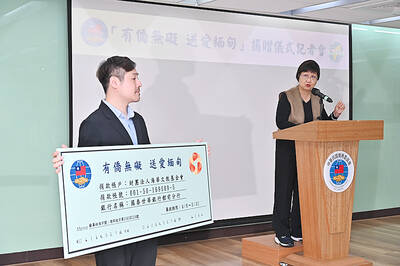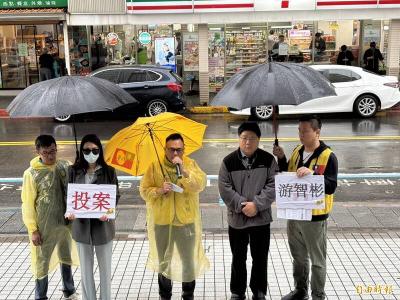The navy showcased the medical capabilities of a newly acquired supply vessel yesterday shortly after it formally took delivery of the craft, which is expected to enhance Taiwan’s combat capabilities at sea, as well as its ability to provide humanitarian assistance.
The Panshih was formally delivered to the navy by local shipbuilder CSBC in a ceremony at Kaohsiung Port yesterday.
The navy opened the new vessel to the media shortly after the ceremony to give people a closer look at its medical facilities.

Photo: Chang Chung-yi, Taipei Times
There is a small hospital on the ship that includes an operating theater, a dental room, three regular wards and an isolation ward. It is stocked with advanced equipment, such as endoscopy devices and mobile X-ray machines.
The hospital would provide medical services for Tawian’s military personnel and would also be able to offer treatment for disaster victims when it is deployed on international humanitarian aid missions, the navy said.
In order to provide a better quality of life for servicemen and women and officers on board, there is a gym and a social room where they can watch TV when they are off duty.
Having received the Panshih, the navy said it would now begin training personnel to familiarize them with the craft before formally entering the ship into service.
The vessel would be used to transport fuel, ammunition and other supplies to naval vessels in the event of war.
In peacetime, it is mainly to be used to carry supplies, conduct maritime rescue missions and provide humanitarian assistance, the navy said.
Currently, the navy only has one supply vessel in service, the Wuyi.
Captain Cheng Nai-pin (鄭乃斌), who will be the first captain of the Panshih, praised the vessel’s mobility, stability and ability to travel long distances and carry large amounts of supplies.
“We also have advanced medical equipment to provide better medical services than the Wuyi,” he told reporters on the sidelines of the ceremony. “The Panshih is also more stable than the Wuyi.”
Despite its supply and support functions, the ship is also well armed to maintain a certain level of defense capabilities, a navy official said.
The weapons on the Panshih include the Phalanx close-in weapons system, a 20mm Gatling gun and short-range Sea Chaparral surface-to-air missile, the official said.
Commissioned by the navy, CSBC began construction of the Panshih in 2011, and the vessel was christened in November 2013. It cost NT$4.09 billion (US$130.1 million) to build, according to the navy.
It was named after Panshih Mountain in Hualien County. The words suggest a sturdy and unwavering foundation.
The new vessel is 196m long and 25.2m wide, can take a crew of up to 165 and has a range of 8,000 nautical miles (14,816km).
It can reach a maximum speed of 22 knots (40.74kph) and has a load displacement of about 20,000 tonnes (18,143 tonnes) and a light displacement of about 10,000 tonnes (9071 tonnes).

Taiwan is stepping up plans to create self-sufficient supply chains for combat drones and increase foreign orders from the US to counter China’s numerical superiority, a defense official said on Saturday. Commenting on condition of anonymity, the official said the nation’s armed forces are in agreement with US Admiral Samuel Paparo’s assessment that Taiwan’s military must be prepared to turn the nation’s waters into a “hellscape” for the Chinese People’s Liberation Army (PLA). Paparo, the commander of the US Indo-Pacific Command, reiterated the concept during a Congressional hearing in Washington on Wednesday. He first coined the term in a security conference last

A magnitude 4.3 earthquake struck eastern Taiwan's Hualien County at 8:31am today, according to the Central Weather Administration (CWA). The epicenter of the temblor was located in Hualien County, about 70.3 kilometers south southwest of Hualien County Hall, at a depth of 23.2km, according to the administration. There were no immediate reports of damage resulting from the quake. The earthquake's intensity, which gauges the actual effect of a temblor, was highest in Taitung County, where it measured 3 on Taiwan's 7-tier intensity scale. The quake also measured an intensity of 2 in Hualien and Nantou counties, the CWA said.

The Overseas Community Affairs Council (OCAC) yesterday announced a fundraising campaign to support survivors of the magnitude 7.7 earthquake that struck Myanmar on March 28, with two prayer events scheduled in Taipei and Taichung later this week. “While initial rescue operations have concluded [in Myanmar], many survivors are now facing increasingly difficult living conditions,” OCAC Minister Hsu Chia-ching (徐佳青) told a news conference in Taipei. The fundraising campaign, which runs through May 31, is focused on supporting the reconstruction of damaged overseas compatriot schools, assisting students from Myanmar in Taiwan, and providing essential items, such as drinking water, food and medical supplies,

New Party Deputy Secretary-General You Chih-pin (游智彬) this morning went to the National Immigration Agency (NIA) to “turn himself in” after being notified that he had failed to provide proof of having renounced his Chinese household registration. He was one of more than 10,000 naturalized Taiwanese citizens from China who were informed by the NIA that their Taiwanese citizenship might be revoked if they fail to provide the proof in three months, people familiar with the matter said. You said he has proof that he had renounced his Chinese household registration and demanded the NIA provide proof that he still had Chinese